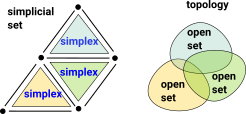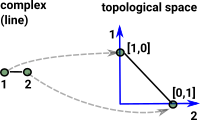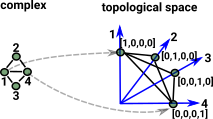This page follows on from the discussion of delta complexes here. We now want to represent this topology in algebra terms. |
 |
We start by defining two functions on δ (functions from a function to a subset) which define subsets of the codomain and domain respectivly:
- Boundary: boundary at n given by Im δn+1
- Cycle: cycle at n given by Ker δn
where:
- Im is the image of δ which is the subset of a function's codomain which is the output of the function on a subset of its domain.
- Ker is the kernel of δ which is the subset of the domain which maps to zero. (gives partition of the domain that expresses equivalence).
Example 1 : Circle
A circle (not filled in) is topologically equivalent to an empty triangle.
 |
So our faces are:
|
We can calculate cycles and boundaries as follows:
Boundary
We can now relate them using the boundary function. This boundary function removes each element in turn and alternates the sign.
B0 = Im δ1 = a-b, a-c, b-c
- δab = a-b
- δac = a-c
- δbc = b-c
So the boundary of the edges is the verticies.
B1 = Im δ2 = 0
The boundary of 0 is 0.
Higher order boundaries are all zero.
Cycles
The cycles are given by the 'kernel' of δn which are the 'chains' which map to zero
Z0 = Ker δ0 = a,b,c
This is given by the kernel of δ0 which are the vertices which map to zero, and they all map to zero because δ0 maps everything to zero.
Z1 = Ker δ1 = ab->bc->ca , bc->ca->ab , ca->ab->bc
We want the kernel of δ1 which are the edges which map to zero, here 'zero' can be interpreted as the identity mapping (a mapping from an element back to itself). So the cycles are the loops around the circle starting at any vertex and ending on that vertex.
Z2 = Ker δ2 =
Example 2 : Disk
A disk (filled in circle) is topologically equivalent to a solid triangle.
 |
So our faces are:
|
We can now relate them using the boundary function:
- δabc = ab -ac + bc
- δab = a-b
- -δac = c-a
- δbc = b-c
This boundary function removes each element in turn and alternates the sign.
So if we apply boundary twice we get:
δ(δabc) = δ(ab -ac + bc)
= (a-b) + (c-a) + (b-c)
= 0
So, in this case, applying boundary twice gives zero.
| In fact applying delta twice always gives zero: | 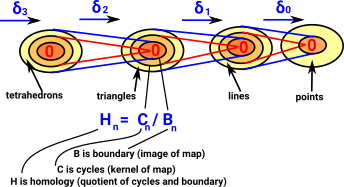 |
Chains
In the earlier examples we just looked at the delta operator on single triangles. Here we look at a chain of triangles: This gives the boundary of the shape. |
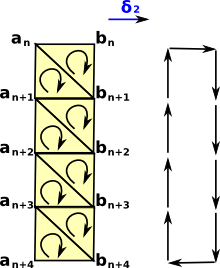 |
As a Free Abelian Group
Now we allow integer multiples and sums of these. If i,jk... are integers then we have:
δ( i ab - j ac + k bc) = i (a-b) - j (a-c) + k (b-c)
= (i-j) a + (k-i) b + (j-k) c
This gives a free abelian group isomorphic to Z.
Chain Complex as a Sequence of Abelian Groups or Modules
| C0 | Zero dimensional chain Elements of C0 are intergral linear combinations of vertices such as: 2x+7y+5z |
| C1 | One dimensional chain Elements of C1 are intergral linear combinations of edges such as: 2xy+7xz+5yz |
We now treat δ as a group homomorphism which extends *.
δ(C1)->C0
Being a group homomorphism means respecting the group structure of the two groups, that is,
- δ(u+v) = δ u + δ v
- δ(u-1) =(δ u)-1
It also respects the extra structure that groups are required to be continuous.
Algebraic meaning of cycle: δ(X) = 0
We find cycles by finding null space of augmented matrix.
Co-Chain Complex
The difference between co-chain complex and a chain complex is that, in a co-chain complex the boundary operator increases the dimension rather than decreases it.
Next Steps
For information about how this can be implemented in computer code here.
Or to continue on the theoretical route see how this is used in homolgy here.
